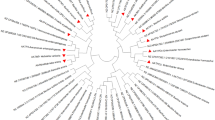Abstract
Bacillus sphaericus (Bs) is a potential mosquito larvicide especially against Culex quinquefasciatus (Say), the vector of bancroftian filariasis. It is a gram-positive, aerobic and endospore-forming bacterium. During sporulation, it synthesizes binary endotoxins (molecular weight 42 and 51 kDa proteins) that are highly toxic to mosquito species. The mode of action of the binary toxin of this biolarvicide in the alimentary canal and the ultrastructural events in the tissues of the affected larvae have been demonstrated. Lysosomal components are the most important organelles involved in the metabolism of the foreign molecules encountered by the cells. In this paper, we report the ultrastructural changes in the midgut epithelial cells, with special emphasis on lysosomes (L), in untreated Cx. quinquefasciatus larvae and those treated with the Bs-IAB59 bacterial strain. In the Bs- treated larvae, the size of the L gradually increased, and within 16 h, fine filaments appeared and compartmentalized into small lamellar bodies, within the L. After 36 h, these lamellar bodies appeared to be collapsed, and later disintegrated in the 48th hour. In the untreated larvae, such ultrastructural changes in the L were not seen. These observations suggested that, though the target site of action of the Bs toxin is the midgut epithelial cells, ultrastructural changes in the L compartments play a vital role in the mortality of the mosquito larvae.
Similar content being viewed by others
References
Baumann P., Baumann L., Bowditch R. D. and Broadwell A. H. (1987) Cloning of the gene for the larvicidal toxin of Bacillus sphaericus 2362: evidence for a family of related sequences. Journal of Bacteriology 169, 4061–4067.
Baumann P., Clark M. A., Baumann L. and Broadwell A. H. (1991) Bacillus sphaericus as a mosquito pathogen: properties of the organism and its toxins. Microbiological Reviews 55, 425–436.
Charles J.-F. (1987) Ultrastructural midgut events in Culicidae larvae fed with Bacillus sphaericus 2297 spore/crystal complex. Annals of Microbiology (Institute Pasteur, Paris) 138, 471–484.
Charles J.-F. and de Barjac H. (1983) Action des cristaux de Bacillus thuringiensis var. israelensis sur l’intestin moyen des larves d’Aedes aegypti L., en microscopie electronique. Annals of Microbiology (Institut Pasteur, Paris) 134A, 197–218.
Davidson E. W. (1979) Ultrastructure of midgut events in the pathogenesis of Bacillus sphaericus strain SSII-1 infections of Culex pipiens quinquefasciatus larvae. Canadian Journal of Microbiology 25, 178–184.
De Duve C. and Wittiaux R. (1972) Functions of lysosomes. Annual Review of Physiology 28, 435–492.
Karch S. and Coz J. (1983) Histopathologie de Culex pipiens Linne (Diptera, Culicidae) soumis a l’activite larvicide de Bacillus sphaericus 1593-4. Cahiers ORSTOM Series Entomologie Medicale et Parasitologie 20, 225–230.
Nicolas L., Nielsen-Leroux C., Charles J.-F. and Delecluse A. (1993) Respective role of the 42- and 51-kDa components of the Bacillus sphaericus toxin overexpressed in Bacillus thuringiensis. FEMS Microbiology Letters 106, 275–279.
Poopathi S. and Anup Kumar K (2004) Novel fermentation medium for the production of Bacillus thuringiensis serovar israelensis, in mosquito control. Journal of Economic Entomology 96, 1039–1044.
Poopathi S., Charles J.-F. and Nielsen-Leroux C. (2002) Alternative methods for preservation of mosquito larvae to study binding mechanism of Bacillus sphaericus toxin. Journal of Invertebrate Pathology 79, 132–134.
Singh G. J. P. and Gill S. S. (1988) An electron microscope study of the toxic action of Bacillus sphaericus in Culex quinquefasciatus larvae. Journal of Invertebrate Pathology 52, 237–247.
Singh G. J. P., Schouest L. P. Jr and Gill S. S. (1986a) The toxic action of Bacillus thuringiensis var. israelensis in Aedes aegypti in vivo. II. The relevance of midgut lesions to its poisoning syndrome. Pesticide Biochemistry and Physiology 26, 36–46.
Singh G. J. P., Schouest L. P. Jr and Gill S. S. (1986b) The toxic action of Bacillus thuringiensis var. israelensis in Aedes aegypti in vivo. II. The relevance of skeletal muscle system lesions to its poisoning syndrome. Pesticide Biochemistry and Physiology 26, 47–55.
World Health Organization (WHO) (1981) Report of informal consultation on standardization of Bacillus thuringiensis H14. TDR/BTH-14/811, WHO/VBC/81-828.
World Health Organization (WHO) (1985) Informal consultation on the development of Bacillus sphaericus as a microbial larvicide. TDR/BCV/sphaericus 85.3 WHO/VBC/1-24.
Author information
Authors and Affiliations
Corresponding author
Rights and permissions
About this article
Cite this article
Poopathi, S., Samuel, P.P., Sundaravadivelu, K. et al. Ultrastructural changes in the lysosomes of the midgut epithelial cells of Culex quinquefasciatus (Diptera: Culicidae) following infection with Bacillus sphaericus IAB59 toxin. Int J Trop Insect Sci 28, 185–190 (2008). https://doi.org/10.1017/S174275840820202X
Accepted:
Published:
Issue Date:
DOI: https://doi.org/10.1017/S174275840820202X




